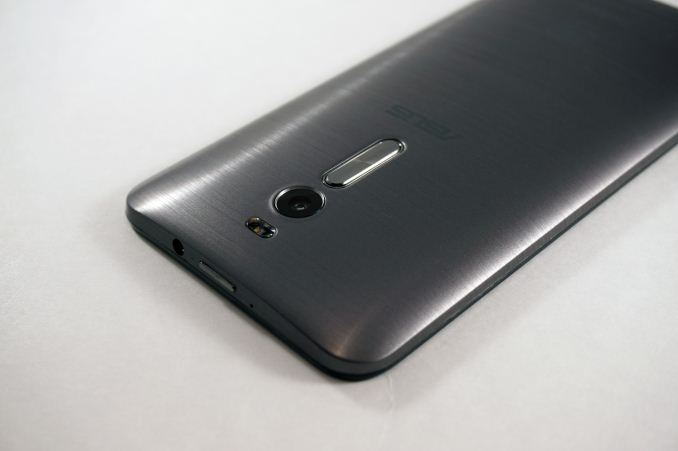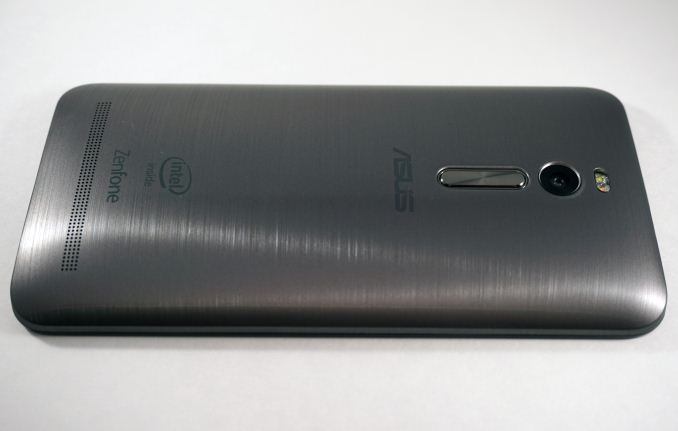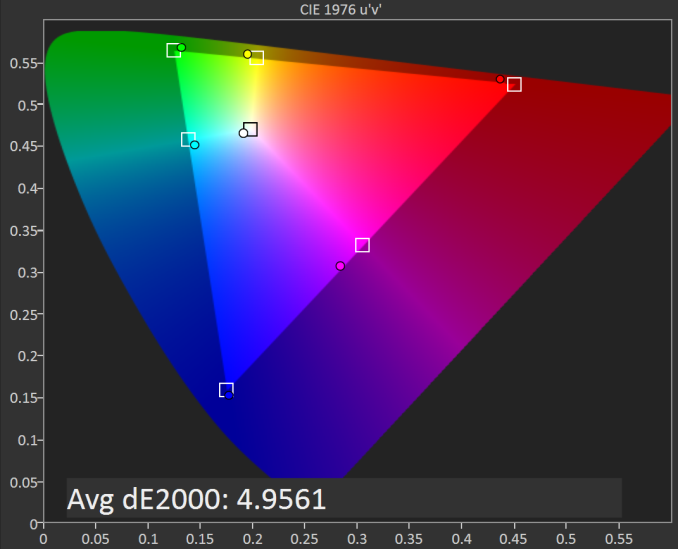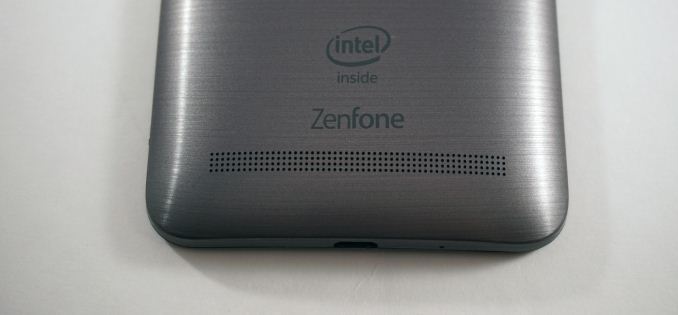
Original Link: https://www.anandtech.com/show/9261/asus-zenfone-2-preview
The ASUS ZenFone 2 Preview
by Brandon Chester on May 18, 2015 2:00 PM EST
ASUS is not new to the smartphone market. Since the days of Windows Mobile (not the new Windows Mobile) they've been selling smartphones. But when it comes to Android devices they've been primarily focused on tablets. ASUS worked with Google to design and manufacture both generations of the Nexus 7, which was beloved by Android enthusiasts. Their PadFone devices were an attempt to have a smartphone that attached to a tablet shell to make a sort of 2-in-1 smartphone and tablet.
However it's only recently that the company has started making a serious push into what has become the traditional Android smartphone space. In 2014 the company had a fairly successful year in the smartphone space with their first generation of ZenFones, however while APAC sales were good they didn't quite make as big of a dent in the North American market as they could have - and likely not as big as they were hoping, I suspect.
This brings us to today with the North American launch of the ZenFone 2, the second generation ZenFone, and ASUS's second shot at making a major wave in the North American smartphone market. After initially going on sale in ASUS's home country of Taiwan on March 8th, and more recently in Japan and India, today ASUS is bringing over their latest phone to North America, where it will go on sale as an unlocked device through retailers like Amazon and Newegg.
It's hard to say which previous ASUS device the ZenFone 2 is a sequel to. It's actually a bit of an outlier compared to ASUS's earlier Android phones. Starting with the 2015 generation of ZenFones, ASUS has clamped down on the number of models they have released, ditching their broad spectrum of ZenFones in many sizes for fewer, more distinct models. As a result the last-generation ZenFones, the ZenFone 4, the ZenFone 5, and the ZenFone 6, have all been replaced with a single product, the ZenFone 2. The naming is a bit unfortunate in light of ASUS's earlier, sized-based naming scheme, but ultimately the point to take away from all of this is that what we're looking at is the second generation ZenFone. On a generational basis then, it's probably most accurate to call it a successor to the ZenFone 5, as it's similar in screen size and the ZenFone 2 is a natural progression when it comes to specifications.
In North America the ZenFone 2 is the first of ASUS's 2015 ZenFone products to launch, and it is the company's flagship smartphone for 2015. You won't see the budget ZenFone C here, and meanwhile the only other member of the ZenFone family will be the forthcoming ZenFone Zoom. As opposed to being another smartphone, the Zoom will be ASUS's take on a true cameraphone, combining a more complex point & shoot optics system - complete with optical zoom - with a traditional smartphone.
As for today's product launch, much like its 2014 predecessors, ASUS is coming out swinging with very aggressive pricing on the ZenFone 2. With the entry level model coming out at $199 and the most expensive model at $299, at first glance it seems strange to call the ZenFone 2 ASUS's flagship smartphone. At these prices the immediate competition for the ZenFone 2 would appear to be devices like the Moto G and the Lumia 735. But don't let yourself be deceived by the price. The ZenFone 2 has some extremely impressive specifications for a low cost smartphone, launching with a fairly powerful Intel quad-core Atom SoC, 2GB+ of RAM, and a 5.5" 1080p IPS screen. As today's article is just a preview to line up with ASUS's launch I won't spend much time going over them today, but you can take a look at an overview of the ZenFone 2's specs below.
| ASUS ZenFone 2 (Base) | ASUS ZenFone 2 (High-End) | |
| SoC | Intel Atom Moorefield Z3560 4x Silvermont @ 1.8GHz |
Intel Atom Moorefield Z3580 4x Silvermont @ 2.33GHz |
| GPU | PowerVR G6430 @ 533MHz | |
| RAM | 2GB LPDDR3 | 4GB LPDDR3 |
| NAND | 16GB + microSDXC | 64GB + microSDXC |
| Display | 5.5" 1920x1080 IPS LCD | |
| Dimensions | 77.2 x 152.5 x 10.9 mm, 170g | |
| Camera | 13MP Rear Facing with F/2.0 aperture 5MP Front Facing with F/2.0 aperture |
|
| Battery | 3000mAh (11.4Wh) | |
| OS | Android 5.0 Lollipop with ASUS Zen UI | |
| Cellular Connectivity | 2G / 3G / 4G LTE (Intel XMM7262 Category 6 LTE) Second SIM 2G GSM (Intel XMM2230) |
|
| Other Connectivity | 802.11a/b/g/n/ac + BT 4.0, GNSS, NFC, microUSB2.0 | |
| SIM | Dual SIM slots | |
| Price | $199 | $299 |
Since I've only had the phone for a couple of days at this point and haven't had a chance evaluate every last aspect of it, I'm going to divide up our coverage a bit. Lining up with today's formal launch from ASUS, I want to start with some of our more interesting data for our readers who are looking for some quick impressions before pulling the trigger. Meanwhile later this week I'll be back with a full review of the phone, including more benchmarks and a look at other aspects such as the camera and battery life.
In terms of construction and build quality, I like the design of the ZenFone 2. The chassis reminds me a lot of LG's larger phones. It curves to a very thin edge, has very thin bezels, and places the volume rocker beneath the camera on the back of the phone. The materials make it look distinctly like an ASUS product, with a brushed finish that reflects light in interesting ways. Although the back of the ZenFone 2 looks like the brushed aluminum on ASUS's high end laptops, it is made of plastic. I would love if it had an aluminum build, at $199 ASUS is already packing in higher specs than competing phones with similar worldwide availability.
The one aspect of the design that I do consider questionable is the placement of the power button. It's located on the top of the device, next to the 3.5mm audio jack. Even though the ZenFone 2 is fairly small for a 5.5" device, it's difficult to reach up to the top to turn it on without having to shift your grip upward. It's not the end of the world, but I would like to see it moved to the right side of the phone for future ZenFone devices. Despite the power button placement, I'm happy with the overall design of the ZenFone 2.
Display
I thought it would be important to give potential buyers some idea of how good the display is on the ZenFone 2. On paper it looks very good, as it's a 5.5" 1920x1080 IPS display. The pixel density isn't as high as the latest generation of 2560x1440 panels, but I find that with an RGB stripe panel the difference between 1920x1080 and 2560x1440 is minimal even at 5.5".
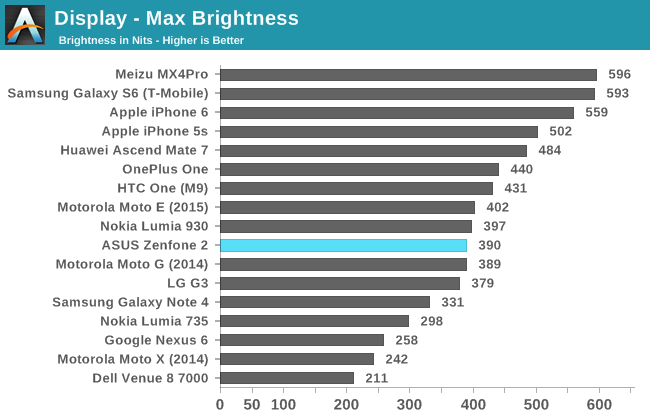
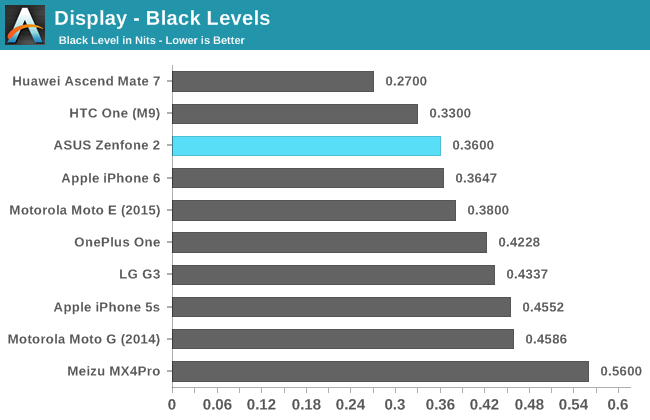
The ZenFone 2 appears to be off to a good start. Black levels are very low among our LCDs, and the max brightness is somewhat low but not terrible by any means. I never had any issues when using the ZenFone 2 outside, although it was definitely not as comfortable as the Galaxy S6.
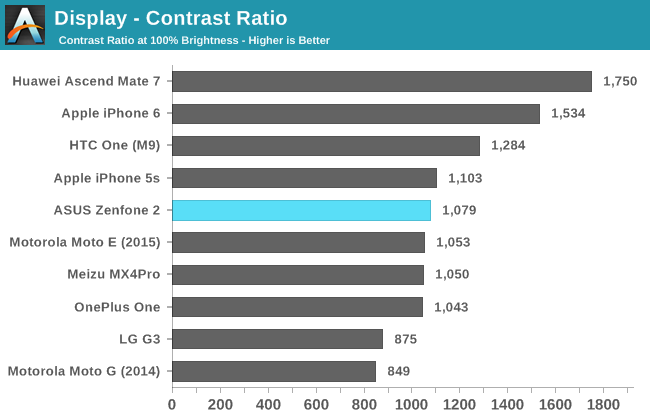
The slightly low max brightness and above average black level results put the ZenFone 2 right in the middle of our LCD devices when it comes to contrast ratio.
Unfortunately, these numbers are somewhat misleading. This is because the ZenFone 2 makes extremely heavy use of dynamic contrast and contect adaptive backlighting. I have never used another device with such dramatic shifts in backlight power. The best example I've found is when switching from an all black to all white screen at max brightness. While this is obviously an extreme case, it illustrates the behavior that is occuring very well. At the moment you switch to white, the brightness of the display is around 170 nits. Over the next few seconds, that brightness rapidly increases to the 390 nits you see in the results above. This is an enormous jump in brightness, and it's very easy to see with your own eyes.
One last thing I'd like to note about the brightness is that the 100% setting on the built in brightness slider is not actually the max brightness that the display is capable of. The max you can achieve using the slider in the Settings app is 319 nits, which is around 82% of the 390 nit result you can get using applications like Brightness Adjuster from Google Play.
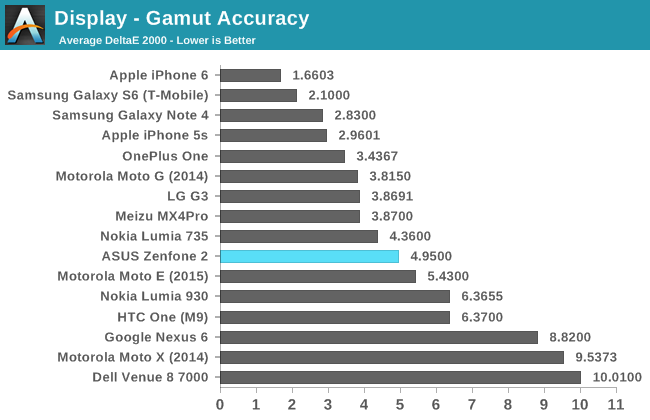
The gamut results are unfortunately not as good as what we've seen from the latest generation of smartphones. The DeltaE for red, blue, and magenta are all just over three, while the remaining three colors are around five. The high error in white also contributes to the higher than optimal overall error.
The complete review of the ZenFone 2 should be posted in the near future, and it will include the remainder of our display workflow. The heavy use of CABC and dynamic contrast has a large impact on the display's performance in some of our tests, and so I'll also be elaborating on where and why that occurs, and what it means for the user. For anyone who really wants to order the ZenFone 2 now, I'll conclude by saying that it's definitely not perfect, but it's still a good display. I think it's by far the nicest one you'll find on a phone that starts at $199 purely because of its resolution.
Performance
Depending on which model you get, the ZenFone 2 will come with either Intel's Atom Z3560 or Atom Z3580 SoC. The former has a max boost clock of 1.8GHz, while the latter has a max of 2.33GHz. It's also important to note that the more expensive model with the Z3580 comes with 4GB of LPDDR3 1600 memory, with the Z3560 models only sporting 2GB. While it's not unheard of to see one of Intel's Atom SoCs in an Android device, this is the first time I've seen it in a smartphone with such wide availability. I'll be talking more about x86 on Android in the final review, but the main point is that the nature of Java applications means that users don't need to be concerned about whether their device uses ARM, MIPS, or x86.
The model we have for testing is the high end Z3580 + 4GB configuration. While I can't make any concrete statements, based on the thermal constraints of smartphones I would expect that Z3580 will outpace Z3560 in race to sleep scenarios where the SoC runs at a high speed for a short period. In more sustained workloads I think that the two phones will perform similarly as they throttle down to manage heat. The extra 2GB of RAM may also be a factor, but it feels more like a future proofing measure, as we don't even see the 3GB of RAM in flagship devices being saturated. Android RAM requirements are also trending downward rather than upward due to the majority of Android sales being inexpensive devices.
To evaluate the performance of the ZenFone 2, I've run it through our standard suite of web and native benchmarks. This section mixes together the more CPU bound and GPU bound benchmarks, and I've just posted the overall score for many of the tests. I'll be looking at the scores for the subtests of benchmarks in the full review to see exactly what areas it performs better in than others.
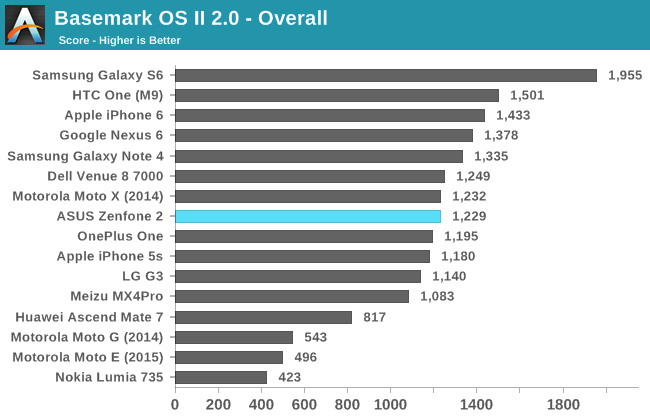
The overall score in Basemark OS II paints the ZenFone 2 in a good light. Its performance when considering every aspect of the hardware ends up being in the same range as the 2014 flagship smartphones. Some of the newest devices pull ahead, with the Galaxy S6 being very far ahead due to its UFS memory. All the devices ahead of it also happen to cost upwards of $500, $600, and even $700, so ASUS and Intel should be proud.
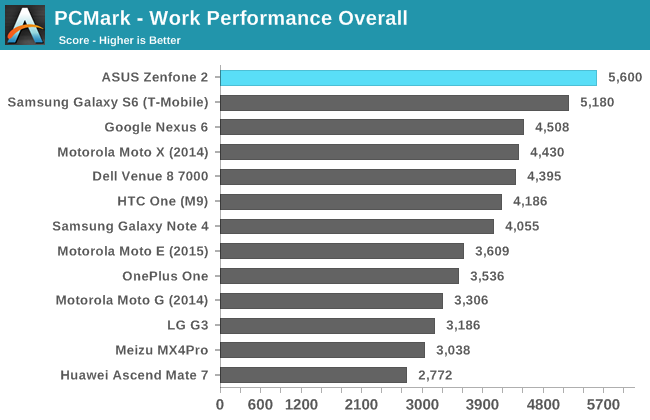
PCMark is a benchmark that emphasizes real world tests. It performs actions like playing and seeking within videos, writing text and into files, etc. All of these are race to sleep scenarios where the CPU should run at its high frequency for a short period and then return to a low frequency to save power. The quad core Atom Z3580 with its 2.33GHz peak frequency pulls ahead of every other smartphone, including the Galaxy S6 which was the previous leader. I'm very impressed with the ZenFone 2's performance here, and it does indeed translate into the same real world tasks that PCMark runs.
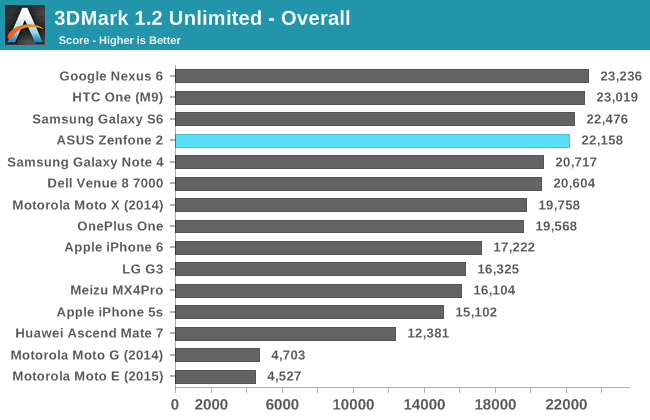
The 3DMark benchmark has both GPU and CPU components. In this test the ZenFone 2 does surprisingly well, with a score that sits among the newest flagship devices.
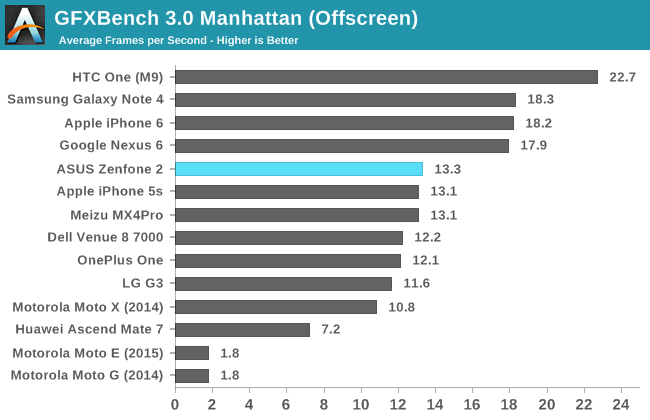
Last, but not least, we have GFXBench's Manhattan benchmark. In this test, we see that the ZenFone 2 performs roughly as well as the iPhone 5s, with a deviation that is small enough to attribute to variance between different runs of the test. It makes sense that the ZenFone 2 performs around as well as the iPhone 5s, as they both share the same PowerVR G6430 GPU. Since the clock speed for the GPU in Apple's A7 chip is unknown, it's not clear whether the ZenFone 2 is at any performance advantage or disadvantage due to driver differences between iOS and Android.
Overall I'm more than pleased with the performance of the ZenFone 2. It's not even worth comparing it to other phones in the $200-300 price range, as it performs at the level of last gen and in some cases current generation flagship smartphones. The GPU in Intel's Moorefield line is definitely the area that needs the most improvement when the next generation of mobile Atom parts comes around. Intel will undoubtably continue to use GPUs from Imagination Technologies, and it will be interesting to see if Intel moves to the PowerVR 7 series with their next generation of SoCs.
Initial Thoughts
Based on the time I've spent using the ZenFone 2 so far, I'm impressed with what ASUS and Intel have managed to create within their price constraints. In some respects, the ZenFone 2 competes with phones that cost substantially more money. In others, it doesn't do quite as well, but it usually outperforms other devices in the $200-300 range by a significant margin, and this is where its real strength seems to lie.
There's a lot to like about the ZenFone 2. While it doesn't support an aluminum or steel chassis, the design is still very nice. Personally, these 5.5" devices are still a bit too big for me to use comfortably, but that's more of a personal preference. The display is also very sharp, although the accuracy could be improved. I understand that CABC can be helpful in certain cases to improve battery life, and even Apple employs it in certain scenarios such as full screen video. That being said, employing it constantly can be problematic, and ultimately I don't think the display issues it can introduce are worth it.
In terms of performance, the CPU is competitive at times with this year's fastest flagship devices. Apple, Qualcomm, and Samsung should probably be a bit concerned about ASUS and Intel's efforts to get this kind of performance into devices that cost only $200 or $300, as it significantly compresses the gap between them and $650 flagship phones. Meanwhile the GPU is similar in performance to last year's flagship smartphones and tablets. I think the GPU should definitely be the main area of focus for Intel with future SoCs. Otherwise compared to more similar phones in the $200-$300 range, the ZenFone 2 is well ahead when it comes to both CPU and GPU performance.
Based on what I've seen so far, the choice between the ZenFone 2 and other devices at the same price is looking to be an easy choice if you're concerned with performance first and foremost. The bigger question to tackle for our full review may very well be just what tradeoffs you do make between the ZenFone 2 and the major manufacturer's flagship phones. At $199/$299, ASUS isn't intending to go to go head-to-head with the likes of the iPhone and Galaxy S6, but if the ZenFone 2 can deliver enough of the flagship experience then it has the potential to be a spoiler for users who can accept the compromises in exchange for significant savings.
Wrapping things up, there are still many aspects of the ZenFone 2 to explore. I'm currently in the process of evaluating the camera, battery life, NAND performance, and ASUS's Zen UI for Android. I hope to be able to present that information to all of you soon, and I hope that you'll join me again when the full review of the ZenFone 2 is completed.

